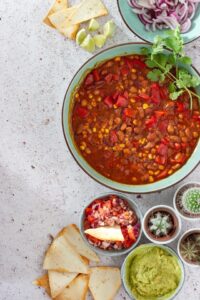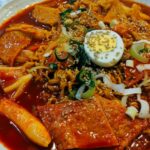Ingredients to make Original Chickpea Stew from Madrid:
- 500 g of beef tenderloin
- 1 piece of bacon or pork belly
- 3 or 4 veal shank bones
- 2 or 3 ham bones
- 250 g Pedrosillano chickpeas
- 750g of water
- 5g salt
- 15g of salt
- 2 chicken hindquarters
- 2 sausages
- 1 rice blood sausage (my family is from Burgos, so this is the only acceptable blood sausage)
- 3 or 4 large potatoes
- 4 or 5 carrots
- 2 cloves of garlic
- 1 cabbage
- extra virgin olive oil

How to make Original Chickpea Stew from Madrid:
1.We start the day before by soaking the chickpeas in a 1% salt brine and triple the weight of the chickpeas in water.
2.That is, for 250 g of chickpeas, 750 g of water and 7.5 g of salt.
3.The salt in the soaking water helps them soften more easily later. We leave them hydrating for at least 8 hours.
4.The next day we blanch the meat and bones to remove impurities and prevent them from going into the soup water.
5.Put all the bones and meat except the chorizo and blood sausage in a pot, cover with cold water and slowly bring to a boil, skimming when necessary.
6.Remove from the water piece by piece, wash them under cold running water and transfer them to the stew pot.
7.The cane bones can be wrapped with a net or a bit of kitchen string, so that they do not lose the marrow.
8.On the other hand, we bring clean water to a boil and blanch the chorizo and blood sausage for a minute to remove the first fat.
9.Then we prick them with a fork to prevent them from bursting during subsequent cooking.
10.In the pressure cooker we also introduce the hydrated chickpeas, better wrapped in a net so that they maintain their shape better and are easy to collect later.
11.We leave the chorizo, the black pudding, and the vegetables out of the moment. Cover with cold water —if the tap water in your area is very hard it will affect the texture of the chickpeas, it is better to substitute mineral water—, and add the salt.
12.We close the pot and put it on the highest heat until the pressure indicator tells us that high pressure has been reached (in most pots it is indicated by a second red line), we lower the heat so that the pressure is maintained and we keep 10 minutes.
13.Once the time has elapsed, turn off the heat and let the pressure drop by itself.
14.Meanwhile, we peel and cut the potatoes into quarters and the carrots into two or three pieces.
15.Cabbage, if you like it —not me, but my wife does—, is prepared by searing, removing the central stem, cutting it into thick julienne strips and cooking it for 10 minutes covered with water in another pressure cooker. It is then sautéed in hot oil with a few pieces of garlic.
16.When the pot has depressurized, open it, remove the chicken —if you prefer it more cooked, you can leave it— and add the chorizo, the black pudding —there are people who prefer to cook them separately so they don’t add as much fat, boiling for 20 or 30 minutes soft, I do it one way or another depending on the day—, potatoes and carrots.
17.We close the pot again, put on maximum heat until the pressure indicator rises to maximum pressure and keep it there for 5 minutes. We let the pressure drop again on its own.
18.Depending on how hard it is, the shank may need a little more time. In this case we would remove the rest of the ingredients and cook the shank for 5 or 10 more minutes at high pressure.
19.Taste and adjust salt if necessary. Carefully remove each ingredient from the pot, separating it from the broth.
20.Then we filter the broth well, I do it in two stages: first through a fine sieve and then with cheesecloth, several layers of gauze or a 100-micron superbug.
21.After filtering, we defat it. If we are going to take the stew next, we must do it quickly, we can help ourselves with a degreasing jar like the one in this photo or, if we do not have it, we put the broth in a plastic zip bag, close it and cool it surrounded by ice water.
22.The fat will go to the top, so we cut a corner off the bottom and let the broth run out, stopping when the layered fat is about to come out.
23.If we are going to consume the stew the next day, we put the meats (to keep them juicier) and the broth in an airtight container, cool them, put them in the fridge and the next day remove the solidified fat from the top.
24.Before serving, we reheat all the ingredients in part of the broth —in fact, I usually cook a few extra chickpeas and add more water than is strictly necessary.
25.I use the extra broth to reheat the ingredients and save it for soup the next day, I save the chickpeas for other dishes, too, and I reserve the perfectly skimmed broth for the noodle soup—and we cook the noodles in the rest.




